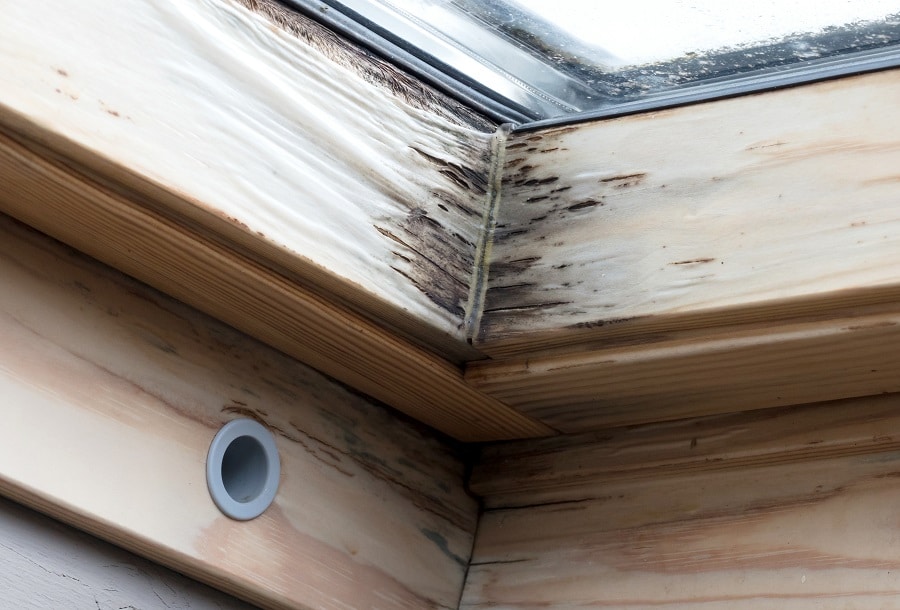Call Our Sussex Damp Experts team now for quote, consultation and advice:
Call on 01273 257 765.

In the United Kingdom, high humidity is the major source of wood problems. This can cause moisture and mould to build in ceilings, walls, and floors, affecting the wood connecting these structures.
Wet rot is the natural rotting of wood caused by excessive moisture. Wet rot requires wood with a moisture content of 30 to 50%, unlike dry rot, which occurs in wood with a moisture content of up to 20%.
Wet rot is caused by a fungus attracted to damp wood and feeds on it, eventually destroying it. There are many distinct types of fungus, but the most prevalent is Coniophora Puteana, often known as Cellar Fungus.
Wet rot is less harmful than dry rot since it is limited to a localised wet region and does not spread. Wet rot, on the other hand, if left unchecked, can be just as devastating as dry rot. It has the potential to weaken structural timbers and cause significant damage severely.

Wet rot spores are drawn to wet wood with high moisture content; therefore, it needs a source of moisture to flourish. This moisture source could be caused by various problems, such as faulty plumbing, leaking gutters, leaking roof, broken pipes, leaking washing machine, or a leaking bath or shower tray. Wet rot thrives in wood that has been exposed to excessive dampness because it causes fungus spores to germinate and proliferate, allowing them to feed on the wood and degrade its structural integrity.
This type of damp occurs when moisture from the ground rises through floors and walls to approximately 1m high, generally leaving a stain line in the walls this high. Rising damp can occur in a building for a variety of causes.
The current damp proof course (DPC) may be deteriorating, sometimes due to rising external ground levels that allow the original damp proof course to be bridged; in older structures, no damp proof course may exist at all.
If a wall is in contact with soil on the outside or the outside protective coating is damaged, moisture can penetrate the wall and raise the moisture levels inside, creating damp on the inside of the wall.
If damp walls are in contact with window and door wood frames or structural timber, this can cause wet rot to appear on the wood.
Condensation is caused by human activities such as cooking, showering and bathing, and drying clothing inside. As a result, condensation is a major source of moisture and mould in both old and new buildings, impacting many of them.
Condensation is more common in inadequately heated and ventilated homes, and it normally gets worse during the winter months, which are referred to as “condensation season” in the industry. Condensation levels can be reduced by using a well-balanced heating and ventilation system.
It is difficult to identify wet rot because it thrives in the dark, poorly ventilated spaces like cellars, lofts, roofs, under floors, window and door frames, and under steps.
The following signs of wet rot can be identified:
Timber will begin to break down due to the high amounts of moisture, resulting in a weaker structure and a sponge-like texture. In addition, the wood and lumber will appear to be a darker tone than it was before.
One of the most problematic aspects of identifying wet rot for property owners is that many wet rot issues develop in areas that are impossible to see or reach. Often, the problems occur right under our feet and knowing the indicators of damp rot can aid in detecting the problem as soon as feasible. While your flooring may appear to be unaffected on the surface, there is always the possibility that there is a damp rot problem beneath your floorboards. Keep an eye out for any bouncy feeling while walking across your floors since this could suggest a breakdown in the wood’s structure.
If you believe you have discovered a wet rot problem, a few telltale indicators will help you identify the problem. The cracking of the wood, which can be cuboidal or linear depending on the kind of wet rot, is one of the most common indications of wood rot.
Fortunately, when wet rot cannot be seen or felt, a moist odour may indicate a problem. Water infiltration can cause dampness in a home, and the smell of damp can lead to a wet rot problem. The odour of damp rot is sometimes described as musty,’ and the air might also feel damp. If it’s something you recognise, you’ll need to do some more research.
Mycelium development can similarly spread over nearby masonry to dry rot. However, compared to dry rot, the proliferation of mycelium with wet rot will be slightly limited. This is owing to dry rot’s capacity to spread to other building materials in a way that wet rot cannot. The presence of thin web-like strands spreading across the surface of the wood is a telltale sign of mycelium growth. The strands expand in search of new food sources, allowing the spread to continue.
Wet rot fungi can infect moist wood, and the wood-destroying fungus grows by breaking down the wood’s cell walls and feeding on the nutrients. This process can be exceedingly destructive to your home’s structure, and it may cause the timber to lose its structural strength.
If you do not treat wet rot, the wood loses its strength and, in some cases, becomes severely unsafe, not only for specific portions of the property such as window frames, door frameworks, and ceilings but for the entire building’s timber structure.
That’s why it’s so important to have a wet rot treatment done as soon as possible.

Sussex Damp Experts has a large selection of goods and brands to choose from. Each situation has its unique set of requirements and limits, resulting in many potential procedures and strategies for treatments and repairs on rot damages. Wet rot should be addressed by professionals as soon as any of the above symptoms appear. Since the longer it is left untreated, the worse it will become and the higher the risk it poses to the structural timbers that keep the property standing.
If you have concerns about wood rot, please call our team of specialists to book an inspection and receive advice on the most cost-effective ways of dealing with the problem. Because no two cases are the same, don’t hesitate to contact our staff at 01273 257 765 to book a survey. One of our surveyors will visit the property and discuss your concerns and requirements to give you a personalised quote.
Call Our Sussex Damp Experts team now for quote, consultation and advice:
Call on 01273 257 765.
Sussex Damp Experts are damp proofing experts who can help you with everything from surveys to treatments and repairs, whether on wood, walls, ceilings, or floors. Our clients include commercial property owners, property management companies, and residential property owners. Our rot treatment experts will precisely assess and identify the severity of the damp problem in your home. Our expertise includes specific damp and timber treatments and rotting timber repairs using the most effective procedures to tackle the problem.
Our experts have received training that meets or exceeds the industry’s standards. Our surveyors are Certified Surveyors in Remedial Treatment (CSRT), ensuring the highest level of service to our customers. Some advantages of choosing our services:
For skilled damp proofing and timber services specialists, call us at 01273 257 765 or send us an email.





Max and his team have been at our property all week and I really can’t thank them enough for the fantastic job they’ve done on plastering both our walls and ceilings. They have literally transformed the appearance of our house! Not only has Ma…

From start to finish Max has been incredable. His knowledge lin damp proofing is second to none and his team where very clean and polite. The plastered finish was like glass so happy we choose Max Plastering for job.

Lovely bunch of lads left a very neat and clean job. Problem was solved.

Perfect Finnish and all left clean and tidy and no mess. Used Max previously and would not hesitate to ask him carry out more work.

Max, Harvey and Stuart arrived promptly as arranged. Done a great job on our outside rear wall. Work completed to a high standard, removal of all old material and cleaned up after themselves. I am so pleased with the standard of their work they ar…

They turned up on time and carried out the works in a very professional manor leaving the front of the house clean and tidy. Very impressed would definitely recommend.

I have to say that on every level Max (with Stuart and Harvey) did an extremely professional job! They explained what they were going to do, they were polite and courteous and respected that they were coming into our home. The plastering is of the…

I called max and he managed to come around the same day to do a survey. The next day I received an extremely detailed survey compared to any other damp proofer which made me feel very at ease that he was going to do the right job. Max and team tur…

Contact Sussex Damp Experts Now to Speak With an Expert.